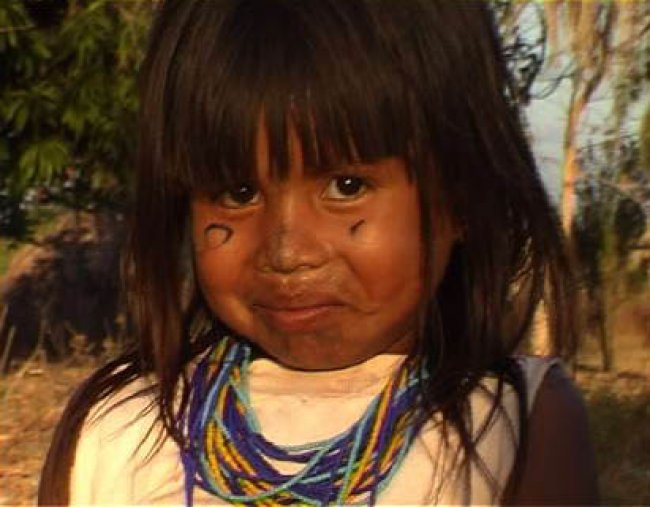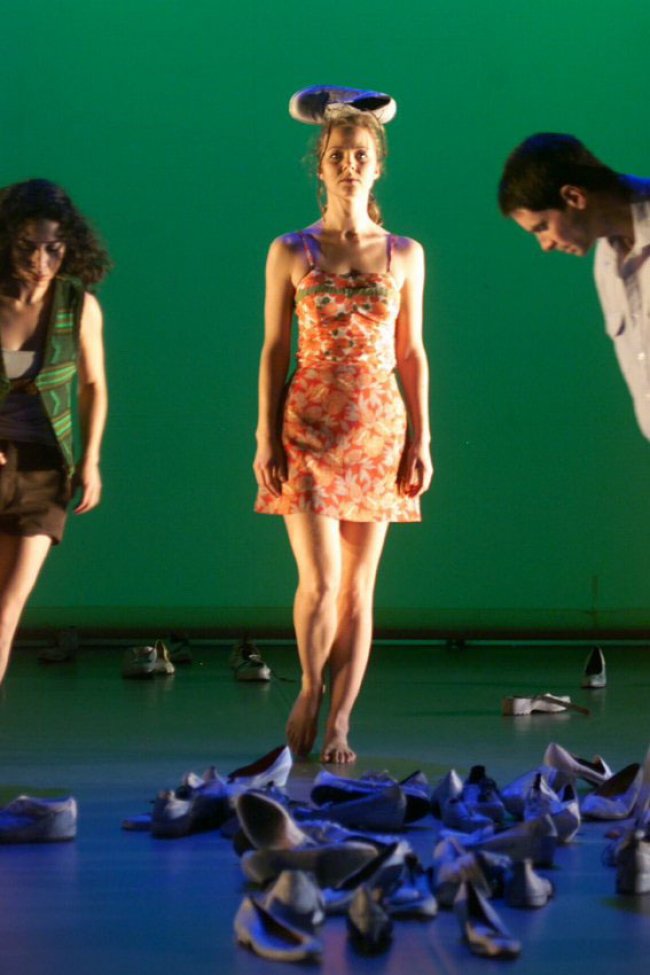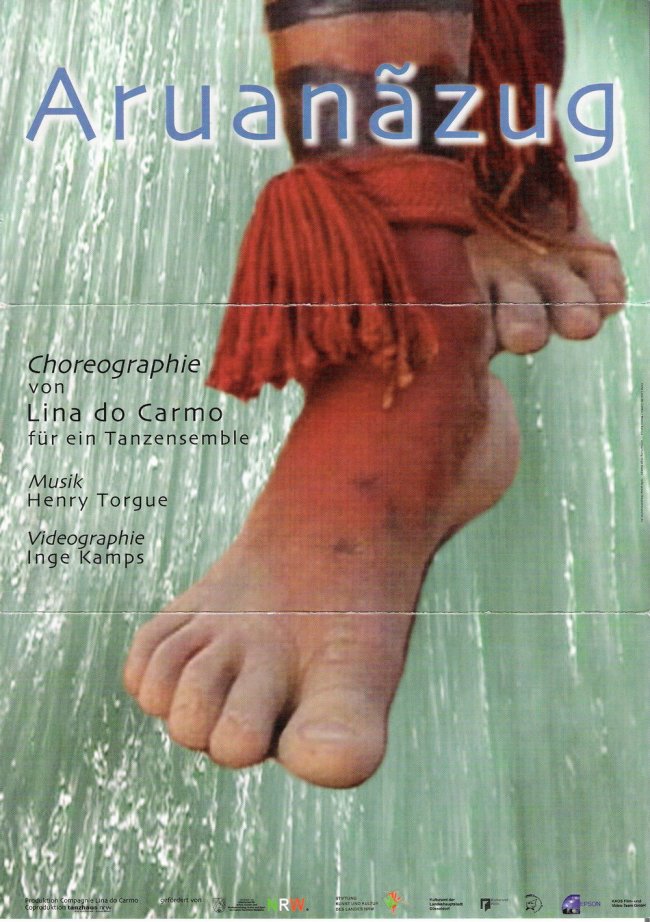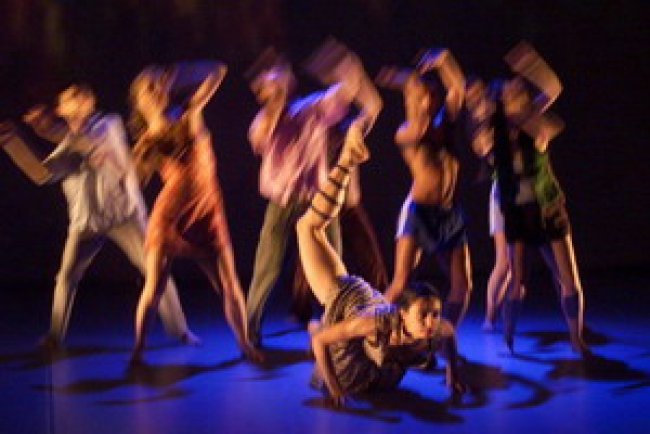Aruanãzug
Devised and choreographed by Lina do Carmo
Music by Henry Torgue
Performed by Company Lina do Carmo
Dancers: Christinan Breuer, Angela Carrasco, Fabiola Ganzalez, Carlos Mujica, Morgan Nardi, Tania Ottava, Rebekka Schaefer, Erik Tepal
In the 21st Century dance is still one of the most vital expressions of the global culture. Man dances across cultural and language borders - at a rave in a European metropolis as well as in the ritual of Brazilian indians. In her production ARUANÃZUG the Brazilian choreographer Lina do Carmo and her company research this coexistence of the archaic and the modern. As a Brazilian that lives and works outside her country since long time Lina do Carmo finds herself between two cultural identities: on one side the impetuous world of contemporary dance in Europe, on the other side the archaic world of the rituals of the indians of her home country. These two poles characterize also the dance production ARUANÃZUG. The »Aruanã Dance« is the most important ritual of the Karajá indians from Central Brazil. It was documented by the Brazilian musicologist Suely Brígido in her work »Images of the Origin«. The ritual narrates the genesis of the cosmos as it was announced by supernatural beings that live under water. Lina do Carmo‘s choreography confronts the archaic ritual with common rituals of the »civilized« world. When she visited the Karajá indians she experienced how the Aruanã Dance and the transistor radio, the collective and the computer exist next to each other nowadays. The experience of the simultaneousness of myth and modern inspired her to create the images of ARUANÃZUG that question the identity in our modern fragmentary society. A second thematical aspect of the choreography is described by the word »Zug« (German for train, migration): migration is one of the characteristics of mankind. In former times whole nations were moving, nowadays individuals. Migration and myth are joined in the stream of images. »Escape and search are part of every version of the genesis. This duality is the beginning of all art« says Lina do Carmo. ARUANÃZUG: from where and where to? It is the of a choreographer‘s cheerful utopia of clasping the world in a dance show.
The music for ARUANÃZUG was composed by Henry Torgue. Since 1979 the French has composed the soundtracks for more than 20 productions of the choreographer Jean-Claude Galotta. Amongst the other choreographers he has worked with are Carolyn Carlson and Kitsou Dubois. In the nineties he has composed the music for two shows of the French director Philippe Genty who is famous for his unique style of visual theatre. ARUANÃZUG is the first collaboration between Henry Torgue and Lina do Carmo.
New production of »Aruanãzug« in 2002 for the Cia ALAYA Dança, Teatro Nacional, Brasília-DF, Brazil. Some impressions: http://idanca.net/lang/pt-br/2010/05/18/alaya-comemora-20-anos-recriando-trajetoria
Production: Compagnie Lina do Carmo • Coproduction: Tanzhaus NRW, Düsseldorf • Die Werkstatt e. V., Wuppertal • in Zusammenarbeit mit dem Europäischen Tanz Festival »Continental Shift« (Lüttich - Aachen - Maastricht) im Jahre 2000
Supported by:
- Ministerium für Kultur des Landes NRW / Bezirksregierung
- Stiftung Kunst und Kultur des Landes Nordrhein-Westfalen
- Kulturamt der Stadt Düsseldorf
- Kulturamt der Stadt Köln
- Fonds Darstellende Künste e.V. Essen
- Epson Deutschland GmbH
Thanks to Akademie Brasil-Europa für Kultur und Wissenschaft, Köln for the Scientific support



The Press
»Myth and modernism ... Lina do Carmo does not create a contrast, but she only outlines the ‘Aruanã-Dance’ to the spheric electronical music that was specially composed by Henry Torgue for this production. The ritual about the creation of the cosmos as an announcement of supernatural beings called ‘Aruanã’ only flashes up in few moments. For example when pirouettes are describing the space in the open nature or when the dancer jump towards the audience as if they want to boost themselves.«
(Ballett Tanz International, Germany)
»‘Everything floats’ - the Greek formula by Heraklit determines through the light design and the floating and stillstanding images the water world of the first part. When the eight dancers in bathing costumes materialise to human beings the mountain of shoes falls from the ceiling. How the bar-footed beings play with it, how they set to work these foreign bodies, this is one of the wittiest scenes of the show.«
(Rheinische Post, Germany)
»The result is a very honest work in which everyone of the eight dancers drops in his personal cultural perceptions.«
(Prinz, Düsseldorf, Germany)






